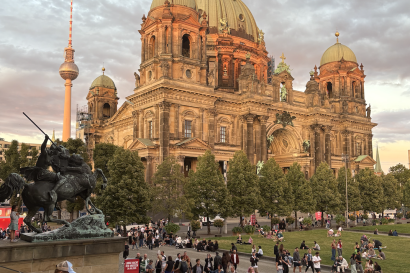“Americans only know Germans for three things: 1. Traditional Bavaria-esque things (i.e. lederhosen, beer, and Oktoberfest), 2. Hitler, and 3. the Berlin Wall.” I’ve heard this statement now twice whilst I’ve been here (there have been other references to American stereotypes of Germans, but this exact phrasing – twice). Once was from a German friend of mine who swims on the Schöneberg Masters Swim Team with me and the other, was from one of my Professors. The more I thought about it the more I realized that they were right – to an extent of course.
Before I took any German classes, and- admittedly- after I took some, the same thoughts crossed my mine when I thought about Germany. Oktoberfest and the massive amount of beer consumed there, WWII and Nazi-Germany, and, finally, the Berlin Wall. Although three large parts of Germany’s history and, somewhat, their culture, I’ve begun to realize- throughout my time here – that Deutschland is a lot more than those three things.
I think what really started this thought-changing process was physically being in Berlin. A place where 2 out of the 3 stereoptypes should be (and can be) seen. Now don’t get me wrong, I’ve taken several classes where loads of other information about Germany has been presented, like their political system and how it functions, different types of literature explaining history before the Nazi Party even existed, and I’ve met Germans (friends and professors alike) that were neither from Bavaria or were Nazis. But even with all this foreknowledge, I couldn’t help but wait to see Berlin’s history (and, admittely, drink my weight in beer).
Yes there is definitely evidence of Nazi Germany and Hitler’s plan for Berlin as a Welthauptstadt (World Capital City) and even more prevalent, is the evidence of a once divided Germany (east and west). For example, all over Berlin there

A example of East Berlin architecture. You can tell by the sense of power it shows
are gold metal tiles in the ground that say: “Hier wohnte… (then comes a name)” which means “here lived (so and so).” This refers to Jewish families that used to live in that specific building that were killed in WWII. Another example is a building that lies on the outskirts of Berlin where the Wansee Conference was held. This conference was held by the Nazi Party leaders to decided what to do with the “Jewish Question” and how to implement the “Final Solution” (which was a highly developed and efficient plan to exterminate all Jews). You can visit the East-Side Gallery where the Berlin Wall is intact or by Nordbahnhof (a train station) where a certain section still reflects how it was earlier (watchtowers, walls, no-man’s land and all). Where there is no longer a wall you can see a brick line weaving throughout the streets showing where it used to stand. On an even larger note, you can easily tell the difference between the architecture in East Berlin from West Berlin (I frequently visit a friend who lives in former East Berlin and everytime I come back to my apartment am amazed by the difference between the two).

The ‘Akademie der Künste’ A great example of West Berlin architecture. You can see by the ingenuity and individuality expressed.
So what then? Here is Berlin, showing those very stereotypes that “every” American thinks of when they think of Germany. I’ve seen them all, so naturally they should be reinforced, right? Not exactly. Hitler, Bavaria, and the Wall can’t describe the amazing dinner I had with my host and experiencing the local ice cream shop down the street. They can’t describe the two punk concerts I’ve been to in Kreuzberg that were in a room no bigger than the living room in my apartment. They can’t describe the people I’ve met who engage me in conversations pertaining to almost anything but the stereotypes “Americans” have. I can see where these people came from and the stereotypes inflicted upon them, but more importantly, I can see how they have evolved from them. When my host describes the Soviet Memorial in Tiergarten as eery, I can barely imagine what it was like in a divided Germany, but is she held down by it? Not at all. When I meet with some of my German friends talks aren’t on past hardships or the Nazi-Time, but rather, on the future of Germany.
So yes stereotypes reflect a certain part of the group they describe, but they are nowhere near an explanation of the group as a whole. Sometimes it takes a real experience to really show this. It could be something harmless like thinking Germans drink beer 24/7 or it could be something much more hurtful like thinking everyone you see is a Neo-Nazi.
So I guess the next time you think about it or find yourself characterizing others in stereotypes, ask yourself if you would like to be characterized by the stereotypes of your nation, group of people, or culture. For Americans: do I want to characterized as lazy? Or always drinking from red solo cups while throwing them on the ground when I’m finished? It could be something harmless like being very patriotic or always watching every American Football game (especially the Superbowl). Nevertheless I would always rather have someone get to know me and experience certain things in my hometown then relying on the things said about it by others. Go out, find a stereotype, and try to prove it wrong.
Evan Weyrauch
<p><span style="color: rgb(29, 29, 29); font-family: Arial, Verdana, sans-serif; font-size: 12px; line-height: normal; background-color: rgb(237, 237, 237);">My name is Evan, I am a student at Carthage College in Kenosha, WI, and am currently a foreign exchange student studying in Berlin, Germany. I enjoy writing, reading, and photography. I meaningful experiences and I try my best to show that meaning through my work.</span></p>




